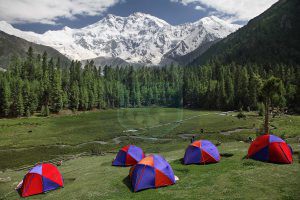Zone: open.
Best time July – End of September.
Duration 22 days
Itinerary:
Islamabad – Peshawar via Khyber Pass – Chital – Kalash- Shandur – Phandar Valley – Gilgit – karimabad Hunza via Atta abad lake – Khunjarab Pass – Gulmit – Gilgit – Skardu – Khapulo – Skardu – Deosai plains – Astore Rama Lake – Fairy meadows – Babusar pass To Naran – Islamabad. 
We begin our journey in Islamabad and proceed to the beautiful alpine lush green Kaghan valley. This valley rivals any in the American Rockies and the European Alps. From here we drive over the Babusar Pass and enter another realm of the Indus gorge.
gorge.
This is where the monsoons are unable to unleash their torrents as they have exhausted all of their moisture in valleys like the Kaghan. The monsoon clouds have a difficult time going over the Himalayas on their northward journey. From the hot and dusty Indus valley we drive towards the base of the ninth highest mountain in the world; Nanga Parbat. Here we visit the beautiful Rama Lake.
ninth highest mountain in the world; Nanga Parbat. Here we visit the beautiful Rama Lake.
The next part of our journey takes us over the high Deosai plains and into the Skardu valley; the gateway to the Karakoram giants.
The Deosai Plains lie between the Indus River and the southern extension of the Himalayan Range, whose most famous peak is Nanga Parbat (8125m). At an average height of 3800m, the undulating, green, flower-filled meadows are surrounded by snow capped peaks and the drive through these plains is a soul stirring experience
Himalayan Range, whose most famous peak is Nanga Parbat (8125m). At an average height of 3800m, the undulating, green, flower-filled meadows are surrounded by snow capped peaks and the drive through these plains is a soul stirring experience
Deosai Lake, or Sheosar Lake from the Shina language meaning “Blind lake” (Sheo – Blind, Sar – lake) is in the park. The lake, at an elevation of 4,142 metres (13,589 ft), is one of the highest lakes in the world. Its length is 2.3 kilometers (7,500 ft), width 1.8 kilometers (5,900 ft) and average depth 40 metres (130 ft). It is located near the Chilim Valley on the Deosai Plains.
Blind, Sar – lake) is in the park. The lake, at an elevation of 4,142 metres (13,589 ft), is one of the highest lakes in the world. Its length is 2.3 kilometers (7,500 ft), width 1.8 kilometers (5,900 ft) and average depth 40 metres (130 ft). It is located near the Chilim Valley on the Deosai Plains.
Wildlife: The Deosai National Parkwas established in 1993 to protect the survival of the Himalayan Brown Bear,Pakistan’s largest omnivore, and its habitat. Having long been a prize kill for poachers and hunters, the bear now has a hope for survival in Deosai where its number has increased from only 19 in 1993 to 40 in 2005.
Parkwas established in 1993 to protect the survival of the Himalayan Brown Bear,Pakistan’s largest omnivore, and its habitat. Having long been a prize kill for poachers and hunters, the bear now has a hope for survival in Deosai where its number has increased from only 19 in 1993 to 40 in 2005.
The Deosai Plains are also home to the Himalayan Ibex, Red Fox, Golden Marmot, Gray Wolf, the Ladakh Urial, the Snow Leopard, and over 124 resident and migratory birds. Birds in the park include the Golden Eagle, Lammergeier, Griffon Vulture, Laggar Falcon, Peregrine Falcon, Kestrel, Sparrowhawk and Snowcock.
Astore Rama Lake is a lake near Astore in Gilgit-Baltistan, Pakistan. It is on the top of the beautiful Astore Valley, covered with oak trees and greenery.
RamaValleyis thickly forested with huge pine, cedar, fir and juniper trees. The valley is about 3300 meters (10800 feet) above sea level and thus is snow covered for 7-8 months of the year. In summer, it becomes lush green; conditions favored by local shepherds.
From here one can trek to east side of the Nanga Parbat (also known as the Killer Mountain), the world’s 8th highest mountain.
From Skardu we drive along the Indus Highway towards Hunza. Some say that the journey on theIndus High way is much more spectacular than even the legendary KKH.
From Hunza we make an excursion to touch China at the highest paved road border crossing in the world. This is Khunjerab Pass and is located at a height of 4833 m. From Hunza we travel westwards to the Hindukush mountains, home of the Kafir Kalash. These pagan tribes claim descent from Alexander the Great.
Chitral town is the capital of the Hindukush mountain region and is crowned by the 7708 m. Tirichmir. From Chitral we make our way back to Islamabad via Swat and Peshawar. This gives us an ample opportunity to witness tribal Pathan culture. We are also able to observe historical sites such as ChurchillÍs picket and ancient Buddhist carvings.
During this overland Bike tour we traverse the western Himalaya, Karakoram and the Hindukush mountain ranges. We also have fantastic views of Nanga Parbat (8125 m.), Rakaposhi (7788 m.), Diran (7273 m.),Golden Peak(7027 m.) and Ultar (7388 m.).